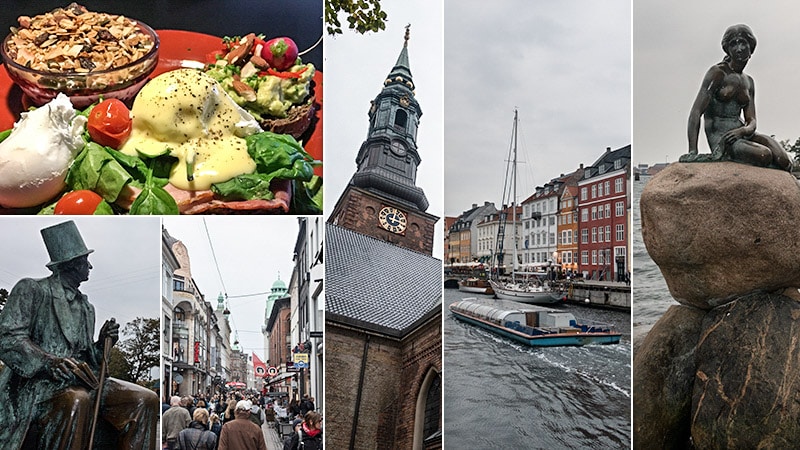
Copenhagen, Day 2. My itinerary included exploring Copenhagen’s major historic tourist sights and delicious restaurants and foods.
This recap is part of a multi-day post of my visit to https://www.thetravelmentor.com/category/copenhagen/ and Stockholm.
If you need to catch up with the journey so far, then you can read about it here:
Day 1: My journey from Los Angeles to Copenhagen, Denmark
Table of Contents
Breakfast at Cafe Dyrehaven
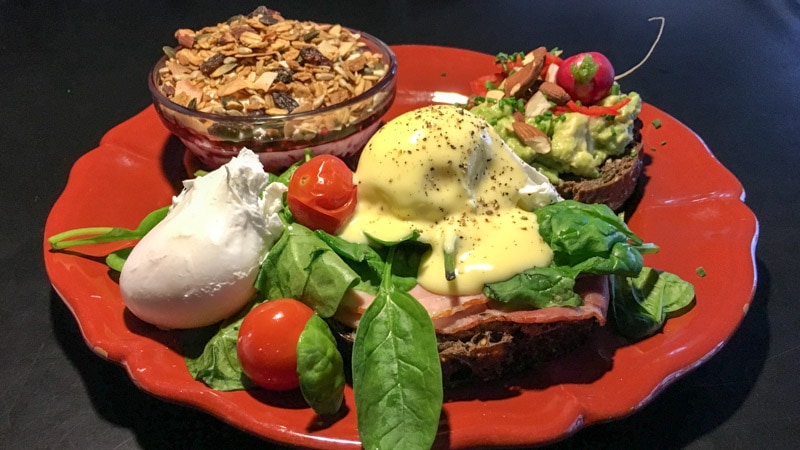
Breakfast is the best way to start the day in a new city.
After a quick search on Yelp, I stumbled across Cafe Dyrehaven, a small, cozy, and funky cafe located in the Vesterbro district about 15 minutes by foot from my hotel.
Cafe Dyrehaven served it all: breakfast, lunch, and dinner.
I came to this spot for the breakfast. More specifically, the Breakfast Plate (120 kroner or about $17.62) with eggs benedict, spinach and tomatoes, muesli, and bread topped with avocado.
This thing was delicious. The eggs were perfect, the hollandaise sauce was luscious, the muesli was crunchy, the avocado spread on the toast was unique and had a great texture, the spinach was fresh and green, and the tomatoes were well-seasoned.
After a delicious breakfast, I was ready for a long day of sightseeing in Copenhagen.
City Hall Square (Rådhuspladsen)
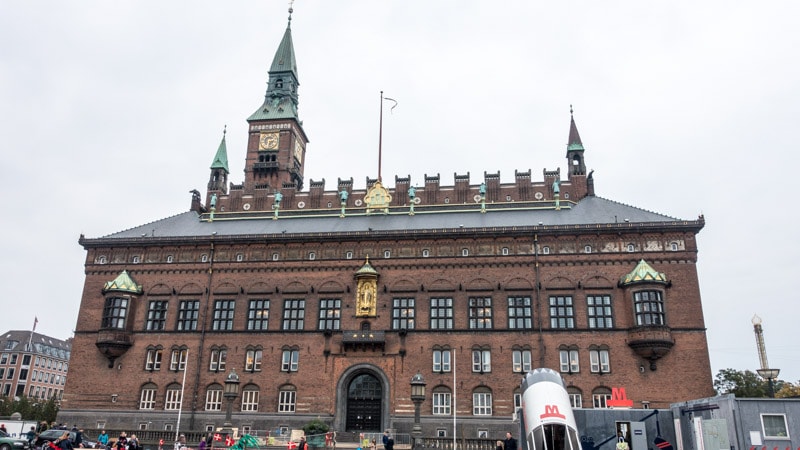
My walk through the heart of Copenhagen began at City Hall Square (Rådhuspladsen), a bustling square in the heart of central Copenhagen.
City Hall and its massive tower dominated the square. At all hours of the day, the square was busy with tourists, people walking around, food carts, lively events, and, unfortunately, construction.
The square was once the location of the Western City Gate. Around 1850, the walls were removed to make more room for the 140,000 people packed inside the city walls.
The large number of people and limited space led to hygiene problems and cholera outbreaks.
If you face City Hall, the Palace Hotel will be on your left. If you want a great photo opportunity, head to the right of city hall to find the seated statue facing Tivoli Gardens.
Statue of Hans Christian Andersen
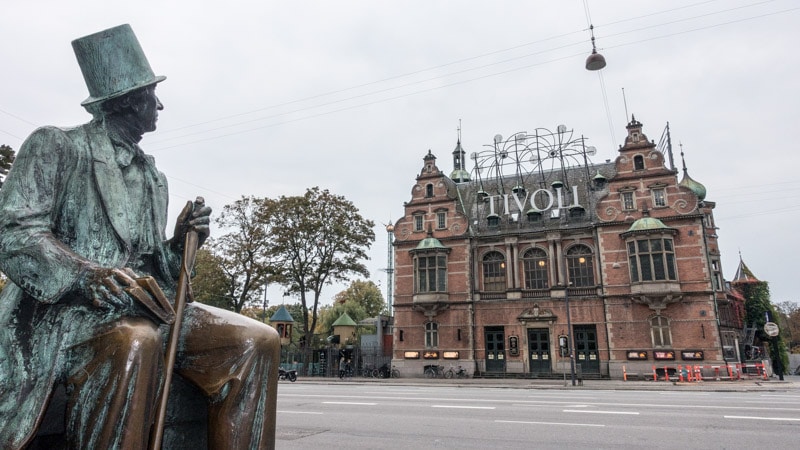
Just to the right of City Hall, across the street from Tivoli Gardens, was the bronze statue of the seated Hans Christian Andersen.
Hans Christian Andersen was a Danish author best remembered for his fairy tales.
If you look closely, you might notice the statue’s well-worn knees. For the perfect photo opportunity, do as the Danes do and climb onto the statue’s knees.
Andersen is looking at Tivoli Gardens, the first great public amusement park in Europe founded in 1843. Tivoli Gardens has inspired many of Anderson’s stories.
Head back into Rådhuspladsen. On the opposite side of the square, near the oddly located Burger King and 7-11, is the entrance to the Strøget.
A walk down the Strøget
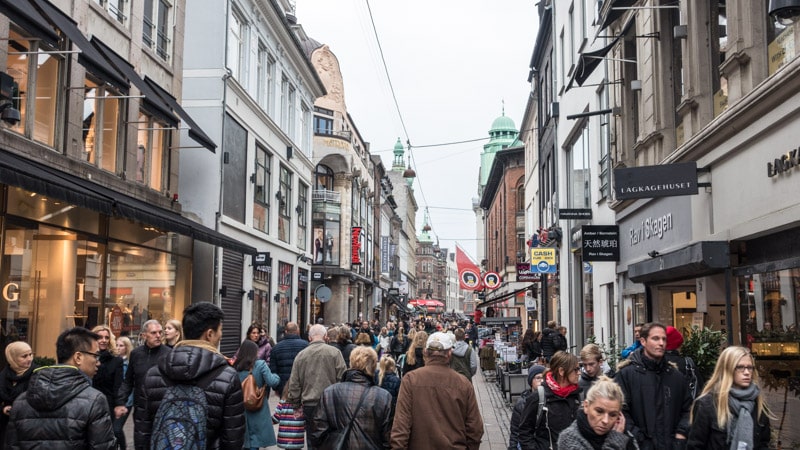
The Strøget is a charming pedestrian shopping street and popular tourist attraction that runs through the heart of Copenhagen. The street runs from City Hall to the Nyhavn (New Harbor) quarter.
As you stroll down the 0.7 mile (1.1 kilometer) Strøget, you will pass by lovely old squares, churches, restaurants, international stores, clothing stores, bars, cafes, souvenir shops, and more.
Though many old buildings that once stood here have been torn down to make way for modern buildings, you can still find many hidden historic gems by wandering off the main drag.
Above the ground floor of many buildings, you can still see some of the 19th-century characters that have survived modernization.
Continuing a few minutes down the Strøget will bring you to a small adjacent square.
Gammeltorv and Nytorv
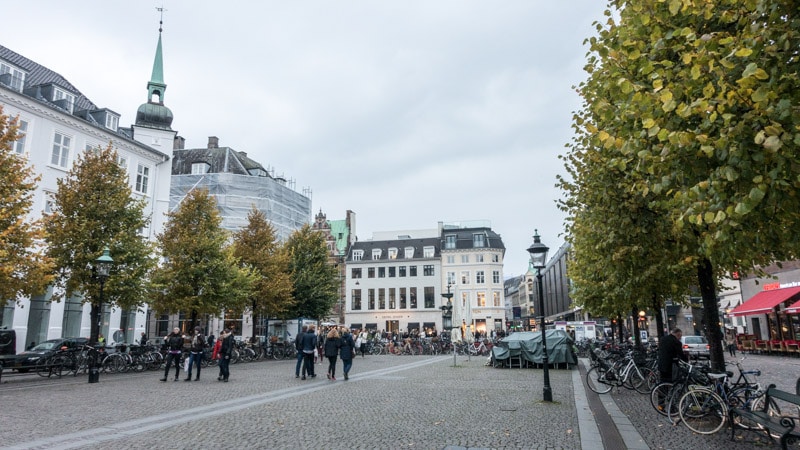
This square found along the Strøget pedestrian street is made up of two small squares: Gammeltorv (Old Square or Old Market) and Nytorv (New Square or New Market). Both made up the old town center.
Gammeltorv, the oldest square in Copenhagen, dates back to the city’s foundation in the 12th century.
Over the years, it has been home to a marketplace, the original town hall of Copenhagen, a meat market, a car park, and finally, a pedestrian square.
The highlight of Gammeltorv is the Caritas Fountain or Fountain of Charity, one of the finest Renaissance monuments in the city.
This fountain has provided drinking water to residents of Copenhagen since the early 1600s. The statue on the fountain features a pregnant woman squirting water from her breasts with a little boy “urinating” into the basin.
At the time, the statue was too progressive. The figures were both corked and raised out of view.
Adjacent to Gammeltorv is Nytorv, the new square. The highlight of Nytorv is the neoclassical facade of the former City Hall and courthouse. Most of the square was rebuilt after the 1807 British bombardment.
In the 17th and 18th centuries, Nytorv was the location of punishment, public humiliation, and executions.
On the pavement on the small raised area near the courthouse is a plaque that reads, “Here stood the town’s kag (whipping post) until 1780.”
Let’s take a quick side trip off the Strøget. From the square, look out for Nørregade. Walk about 100 meters down the street until you reach a large Greek-style building.
The Greek-style Church of Our Lady
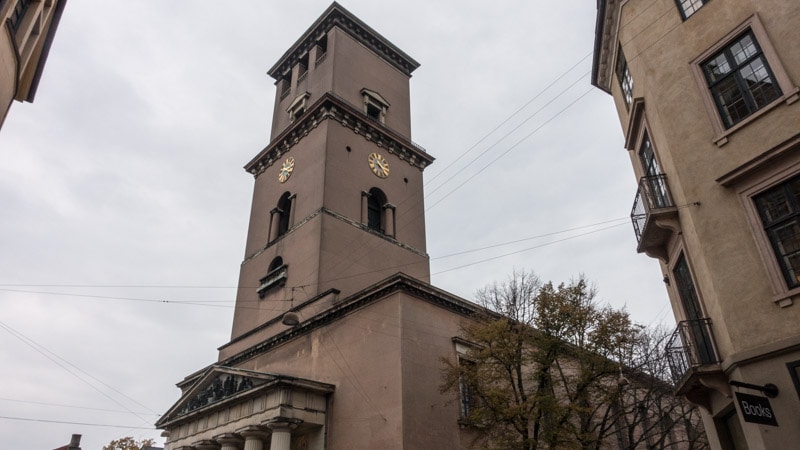
This Greek-style-looking building is known as Church of Our Lady.
In 1521, a young Prince Christian traveled to Germany, where Martin Luther influenced him. When he returned, he sought to take the Danish throne by force and break from the Roman Catholic Church to become Lutheran.
Through his reforms, Christian established Lutheranism as the state religion.
In 1536, Prince Christian was crowned King Christian III at this location.
The original church that once stood at this location was destroyed during the British bombardment of 1807.
The neoclassical-style church, as seen today, was completed in 1829. Architect Christian Frederik Hansen designed it.
The interior of the Church of Our Lady is neoclassical, simple in style, and temple-like. There are no sculptures or paintings of Mary inside.
The nave was lined by sculptures of the 12 apostles, each in a meditative pose holding a symbolic piece.
At the center was the statue of Risen Christ, with Christ wearing a burial shroud with his arms wide open, asking those to come to him.
The visitors center at Temple Square in Salt Lake City, Utah, contains a replica of this statue.
Exit the church and turn right. Continue for about 75 meters until you reach the intersection with Sankt Peders Stræde, where you will see a towering brick church.
The red brick Sankt Peders Church
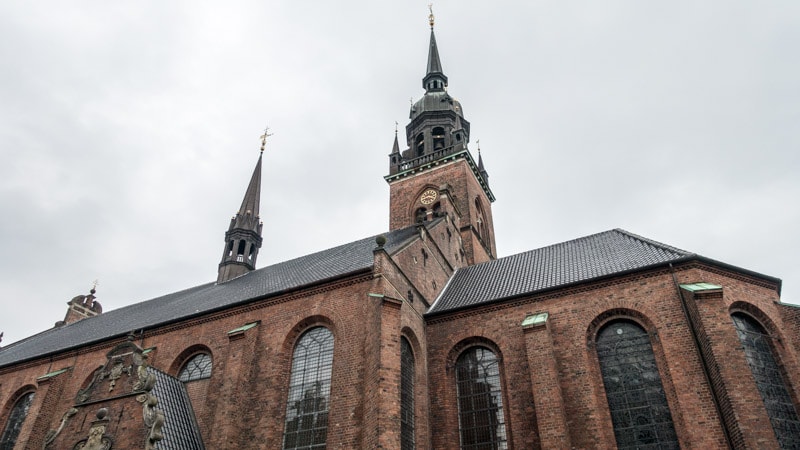
This beautiful red brick church is Sankt Peders Church.
Many parts of the church, such as the nave, choir, and parts of the tower, date back to the 15th century, making it the oldest building in central Copenhagen.
The church’s architecture is Gothic, with Baroque features. Its spire, built in the Rococo style, dates back to 1756-1757.
The church is the parish church of the German-speaking community in Copenhagen. The church still holds services in German to this day.
Unfortunately, during my visit, the church’s interior was closed for the winter, so I went to the next sight.
Head back down Nørregade and rejoin the Strøget. Continue north along the pedestrian street until you reach King’s New Square (Kongens Nytorv), where you will see the colorful buildings of Nyhavn.
The colorful Nyhavn harbor
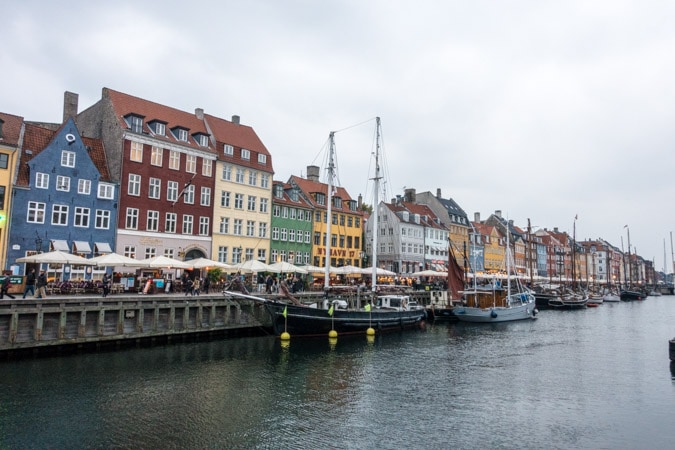
This colorful area is Nyhavn, or New Harbor. It is one of the most beautiful places in Copenhagen and one of my favorite places to visit.
Many of the brightly colored buildings seen today date back to the 17th and 18th centuries. The area was once popular with sailors for its easy access to beer and prostitutes.
Over the years, the buildings have operated as townhouses, restaurants, bars, and cafes.
Today, the area has trendy cafes, jazz clubs, restaurants, bars, tattoo shops, and an eyesore night club.
Many historical wooden ships and old sailboats of all sizes were in the canal.
If you are looking for great photo opportunities, this is your spot.
Walk towards the end of the harbor near King’s New Square (Kongens Nytorv). From here, walk north up Bredgade for about five minutes. When you reach Frederiksgade, turn right to enter the courtyard of Amalienborg Palace.
Amalienborg Palace
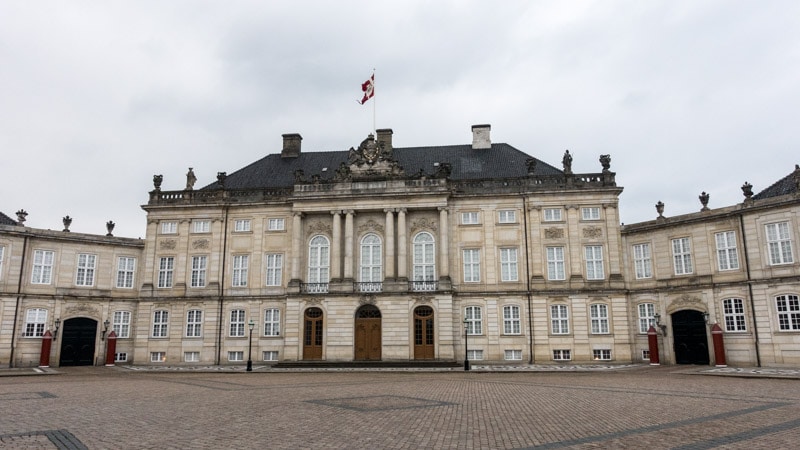
You are now standing in the circular courtyard of Amalienborg Palace.
As you walk into the courtyard, the mansion to your left is Queen Margrethe II’s and her husband’s residence. If the flag is flying, the queen is currently home.
The mansion across the courtyard on the right is Crown Prince Frederik’s and his wife’s residence. Frederik is heir to the throne.
At the center of the courtyard is a statue of Frederik V on horseback. Frederik watches over an area named after him, Frederiksstaden.
The area was a luxury neighborhood for the business elite and nobility during a period of prosperity for Denmark.
It was not until 1794 that the king moved here after a fire destroyed his other palace.
If you have extra time, walk inland from Amalienborg Palace towards Frederik’s Church, commonly known as The Marble Church.
The Marble Church
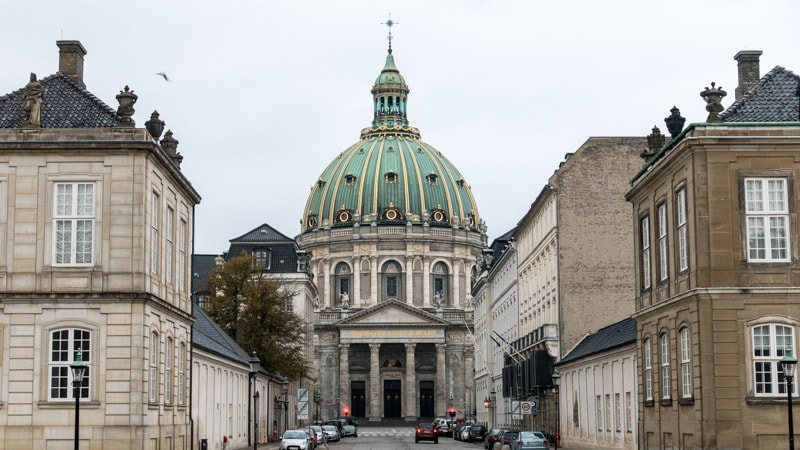
The Marble Church, officially Frederik’s Church, might not be the largest church you have ever seen, but its enormous presence will make it feel that way.
This Evangelical Lutheran church, completed in 1894, is well known for its stunning rococo architecture.
The massive church dome, inspired by St. Peter’s Basilica in Rome, is the largest in Scandinavia at 101 feet (31 meters).
If the church is open, step inside to view its large, peaceful, Pantheon-style interior.
Today, The Marble Church remains an important focal point of the elegant Frederiksstaden district.
From The Marble Church, head back towards Amalienborg Palace and head north towards Kastellet Park.
Gefion Fountain near Kastellet Park
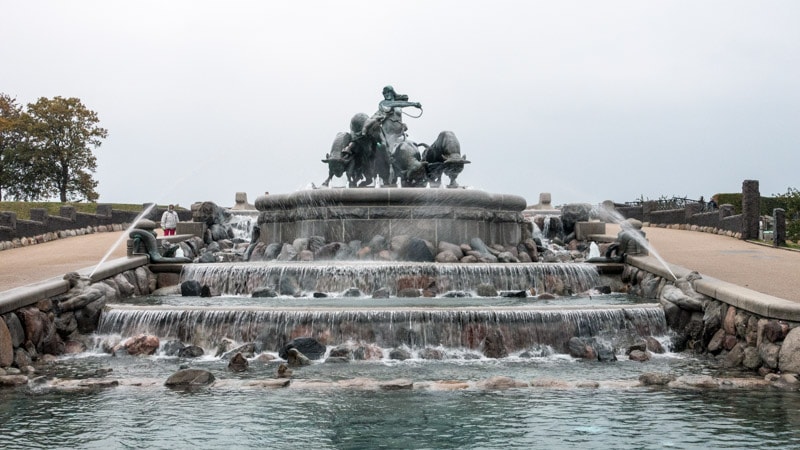
This beautiful fountain near Kastellet Park is known as the Gefion Fountain.
The fountain, designed by Danish artist Anders Bundgaard, is the largest memorial in Copenhagen. The Carlsberg Brewery dedicated it to its 50th anniversary.
The fountain depicts a mythical story about a goddess who was given only one night to create an island from a hunk of Swedish land. The island became Zealand, Denmark’s largest island, which you are currently standing on.
Supposedly, the chunk of land she removed created Vänern, the largest lake in Sweden.
How did she do it? It was easy. She transformed her four sons into the four oxen depicted in the statue, and the oxen did all the heavy-duty work for her.
It was rainy and windy, but I had one more sight to check out before I called it a day.
Continuing for five minutes through the park and along the harbor will bring you to the most famous statue in Copenhagen, The Little Mermaid.
The Little Mermaid, an iconic statue of Denmark
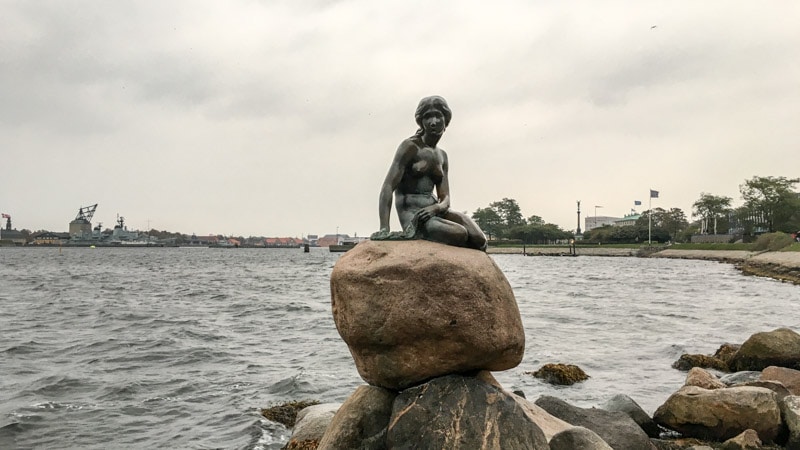
Just past the Gefion Fountain, down towards the water along the Langelinie promenade, was the The Little Mermaid statue.
This bronze statue was a gift from Carl Jacobson, the son of the founder of Carlsberg Brewery, to the city in 1909.
A Hans Christian Andersen fairy tale about a mermaid inspired the idea for the statue. Jacobson wanted to immortalize the mermaid from the story. He hired sculptor Edvard Eriksen to make him a statute; the rest is history.
If you arrive at the right time, you might get a few minutes alone with the statue to snap a few close-up photos.
Other times, there will be busloads of tourists. Just be careful walking along the rocks, as they can be slippery and uneven.
Dinner at Kødbyens Deli
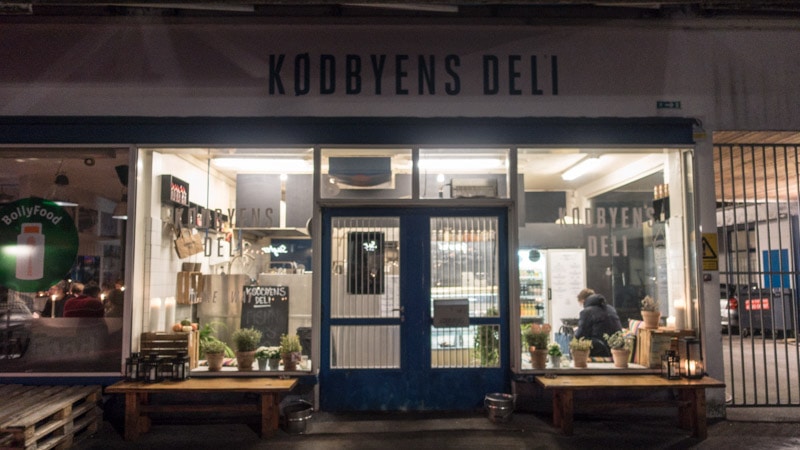
After a long day of sightseeing, it was time to eat.
This time, I headed back to Kødbyen (Meatpacking District) to check out a small but popular place known as Kødbyens Deli.
I read many great things about the small deli, which served delicious English-style Fish n’ Chips, burgers, chili con carne, fish cakes, salads, and more.
There was a small seating area for guests to sit and eat inside. Since the place was so small, most people, including myself, did take-away.

For me, I went with the Fish n’ Chips (80 kroner or about $11.77). This delicious dish came with fresh cod fillets, first beer battered, then tossed in panko bread crumbs and fried fresh.
The two large fish pieces were hot, flaky, and juicy, with a crispy golden brown crust. On the side was a generous portion of thick hand-cut chips.
The tartar sauce accompanying the fish was creamy and perfect, with a hint of lemon juice.
It was the perfect way to end a day. And this completes Day 2 on my visit to Copenhagen.
Last Updated on April 7, 2025
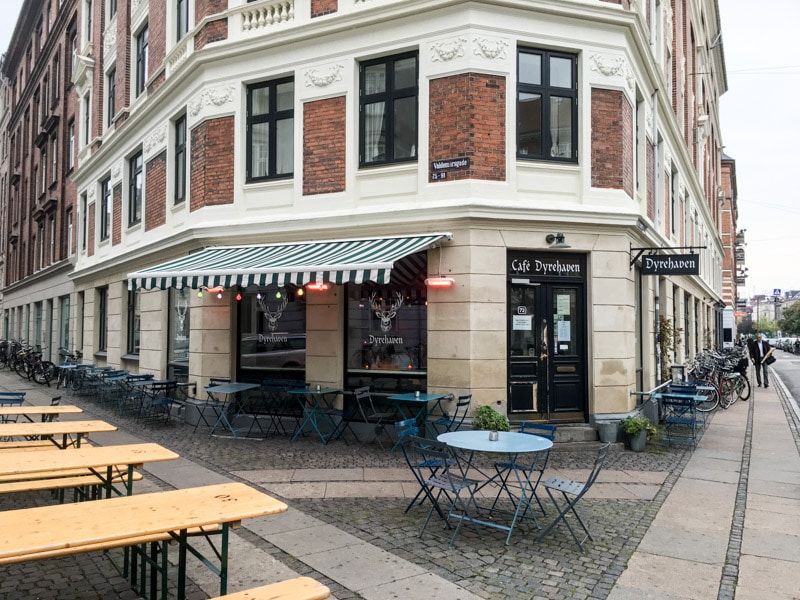
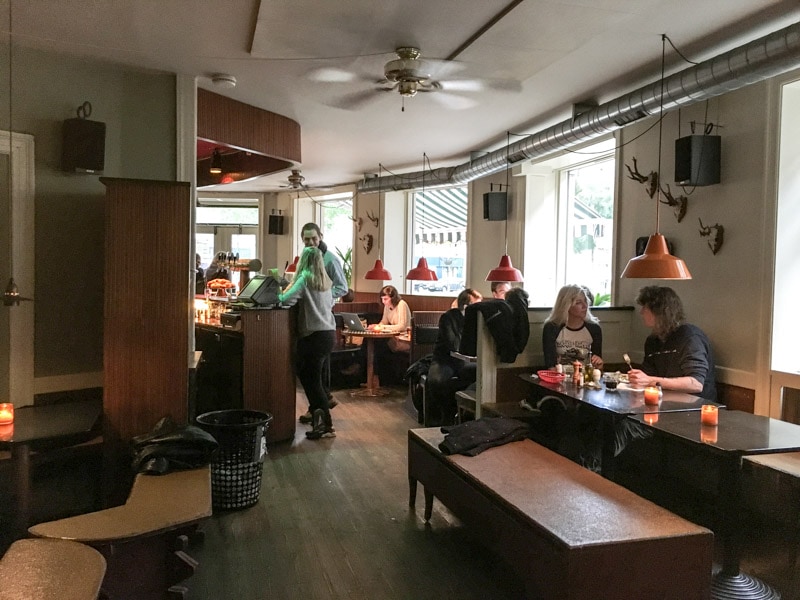
Related Posts